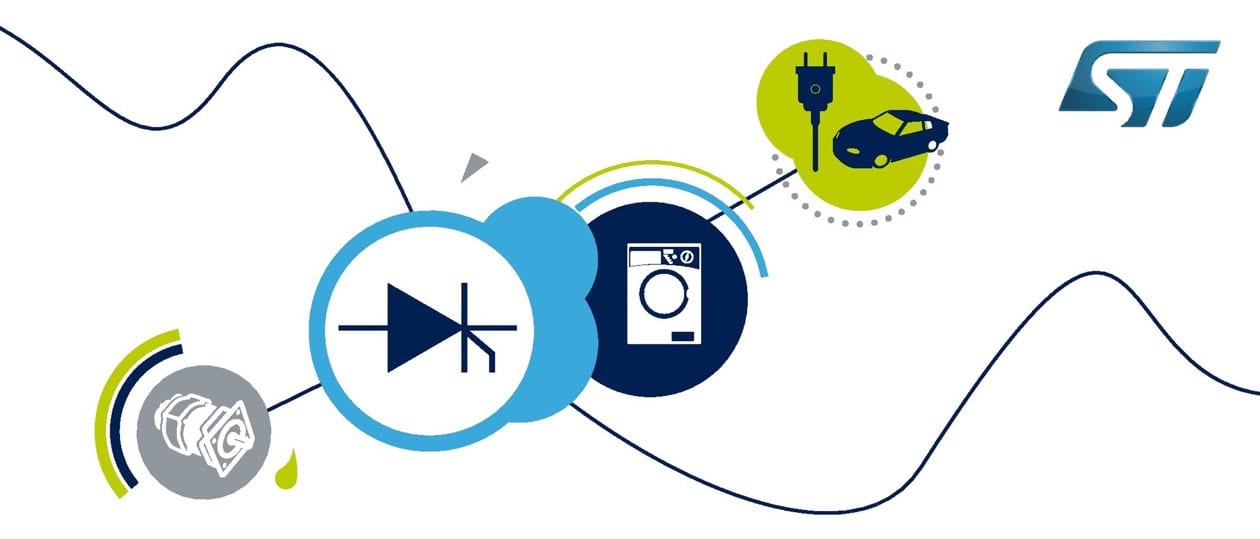Thyristor Finder is the newest mobile application from ST. It makes finding the right thyristor for your design a breeze by simplifying the selection and integration of the right component, and it is currently available on iOS and Android. Crowdfunding offers fresh opportunities and exposure to small teams, allowing them to disrupt markets. However, it also means newcomers, who often have fewer resources or experience, must face design challenges that only big corporations had to deal with previously. One example is understanding the importance of thyristors or AC switches, and finding the right one in a sea of part numbers and specifications. This is the reason why ST isn’t simply manufacturing thyristors, but also sharing its knowledge and expertise through an unparalleled mobile app, support, and online community.
Whereas high power electrical currents, and high voltages, require analog systems, modern electronic is digital and fueled by very low power current. Thyristors act as the go between these two realities. Very simply, they switch ON or OFF the high voltage load, while being controlled by the low power motherboard; moreover, thyristors can be used to modulate the power of an AC load, as in light dimmers.
Thyristors: SCRs, Triacs, Diacs, and ACST
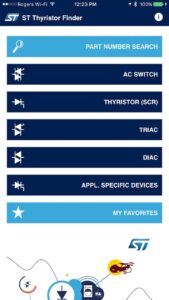
When users open the Thyristor Finder app, they first get a list of components. At ST, “thyristor” is used as an umbrella for the different devices made of four or five semiconducting layers. Within this category, we find:
- Over-voltage protection AC switches (ACST), which have a structure designed to increase their robustness.
- Silicon-Controlled Rectifiers (SCRs), which have three terminals (anode, cathode, and gate) and control the current in one direction.
- Triacs, which have the same terminals, let the current flow in both directions, or block voltage symmetrically. They are therefore suited for applications that rely on an alternating current (AC).
- Diacs, which are triggering diodes, meaning that unlike the last two components, they do not have a gate, and are self-triggering. Hence, they will conduct an electrical current as long as the voltage is above a certain threshold.
Using Thyristor Finder to find an AC Switch, SCR, or Triac requires to either explore the different series ST provides or launch a parametric search. For simplicity’s sake, we’ll limit this overview of the application to the search of a Triac, but the steps to search the other thyristors are very similar.
First Steps on the Right Track
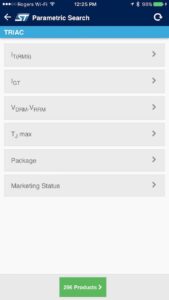
Choosing the right thyristor can feel like a daunting task. Hence, as we review the different parameters narrowing a Triac search, we will also define questions every team must ask itself as it designs its next product.
- How much current on average will pass through the Triac? This will help engineers define the On-state RMS Curent (IT(RMS)), meaning the maximum current allowed in the device at a specific temperature.
- What will be the value of the triggering current? The answer will set the triggering gate current (IGT), meaning the current that must be sent to the gate to turn the thyristor on. This value is of the utmost importance because it will define how a thyristor is integrated into a device. Low power systems can rely on a very simple design using a microcontroller and resistance since basic libraries can control the thyristor. However, a triggering current of more than 10 mA demands a complete command circuit.
- What kind of voltage will power the final product? The answer to that question will determine the AC Load Voltage (VDRM, VRRM) of the thyristor. For instance, when designing a product for countries using 110 V, a 600 V thyristor is the best option, whereas countries using 240 V will need an 800 V component. On the other hand, building for a three-phase power application requires a 1,200 V thyristor.
- What will be the maximum junction temperature? In most cases, an operating junction temperature (Tj) of 125 ºC is enough. However, in certain scenarios, like electric car chargers, thyristors must be more robust and operate at higher temperatures. In this particular instance, it would be recommended to choose a TJmax of 150 ºC.
ST Offers Much More Than Just Thyristors
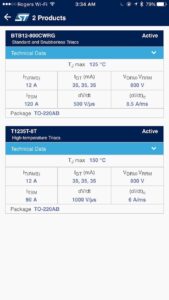
Once teams know the basic type of Triac they need, they can fine-tune the specifications to better fit a particular type of application. For instance, if we use Thyristor Finder to search for a Triac that has an On-state RMS Current (IT(RMS)) of 12 A, a triggering gate current (IGT) of 35 mA, an AC Load Voltage (VDRM, VRRM) of 800V, and a TO-220AB package, we still end up with two products and choosing the right one is all about setting priorities.
In this particular example, the BTB12-800CWRG and T1235T-8T fit the parameters entered. Pressing the “Technical Data” bar for each product allows users to see right away that the BTB12 provides a higher surge robustness (ITSM), but has a rising ratio of voltage (dV/dt) of 500 V/µs, whereas the High-Temperature T Series offers 1000 V/µs. In a nutshell, the latter measurement determines the maximum voltage rate-of-change the Triac can sustain while staying in its off state. In other words, choosing the T Series T1235T will offer greater application robustness and permit a high maximum temperature junction of 150°C. Hence, the T1235T-8T would be better suited in a small design.
More Than Just a Portfolio, ST Has a Community!
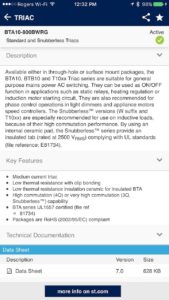
If we take a more practical approach, in which a designer may first want to focus on only certain parameters, searching for a Triac with only IT(RMS) and IGT can lead to a dozen responses, and choosing the right one will demand that engineers ask themselves what they want to focus on: temperature, application robustness, or environmental robustness, knowing that some teams may need to prioritize more than one of these aspects.
For instance, a washing machine will use AC switches (ACS or ACST) with a high-voltage surge capability, to protect against a lightning-induced surge for instance. In this case, the thyristor provides environmental robustness. On the other hand, if a manufacturer is designing an electric car, the Triac must tolerate a wide range of operating temperature, on top of high surges. As a result, it must not only focus on environmental robustness, but also thermal efficiency and application robustness.
To enhance this fine-tuning process, there’s a quick and easy access to each component’s data sheet from within the Thyristor Finder app. On top of it, the ST Community is a fantastic place to get answers from products and applications experts. The Power Management and Motor Control forum is a great tool for designers to get the answers they need and make sure they have the most efficient thyristor in their circuit. ST also offers more than 25 Application Notes ranging from the fundamentals of thyristors to the most recent trending applications. Finally, teams can also contact their local ST representatives if they still need more information.
The ST Touch
ST was the first company to mass produce an automotive-grade thyristor for medium power applications, the TN5050H-12WY, and we continue to innovate as well as offer the biggest portfolio of Thyristors on the market. However, what makes the ST offering special is this desire to listen, guide and empower creators. Thyristors aren’t a basic commodity. They are complex components that can make or break a product and directly contribute to the safety of its users. This is why ST goes well beyond what any other company offers. After all, typing “Thyristor” in Apple’s App Store only yields one result: our app! What ST does like no one else is to ensure the right device gets to the right design, and engineers with projects big or small get the right advice from the market leader in this industry.
To know more about the thyristors you could use in your design, please visit the ST website, and click on the Product Tree on the right column.
- Download ST Thyristor Finder for iOS
- Download ST Thyristor Finder for Android
